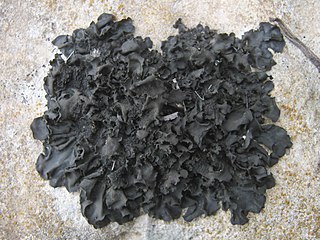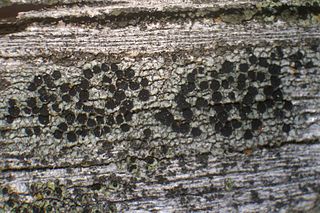
Collema is a genus of lichens in the family Collemataceae. The photobiont is the cyanobacterium genus Nostoc. Species in this genus typically grow on nutrient-rich bark or somewhat siliceous or calcareous rocks in humid environments.

Buellia is a genus of mostly lichen-forming fungi in the family Caliciaceae. The fungi are usually part of a crustose lichen. In this case, the lichen species is given the same name as the fungus. But members may also grow as parasites on lichens (lichenicolous). The algae in the lichen is always a member of the genus Trebouxia.
Buellia peregrina is a species of saxicolous (rock-dwelling), crustose lichen in the family Caliciaceae. It is found in the Namib desert in Namibia.
Austrotrema is a genus of lichen-forming fungi in the family Graphidaceae. It is primarily found in the Australian-Southeast Asian region. The genus is characterized by small, pore-like apothecia with a double margin, faintly amyloid ascospores, and stictic acid chemistry. Austrotrema species grow on tree bark and have a continuous thallus with a cortex that is prosoplectenchymatous–featuring densely packed, filamentous fungal hyphae that run parallel to the surface of the lichen, creating a compact and firm texture. The genus is closely related to Thelotrema and Leucodecton, but can be distinguished from them based on molecular phylogenetic data, specific morphological traits, and its secondary chemistry. Currently, Austrotrema comprises three species.
Aspiciliopsis is a genus of lichen-forming fungi in the family Trapeliaceae. It has two species, both of which occur in the Southern Hemisphere.
Placomaronea fuegiana is a species of saxicolous (rock-dwelling), crustose lichen in the family Candelariaceae. Found in South America, it was formally described as a new species in 2009 by Martin Westberg and Patrik Frödén. The type specimen was collected by the second author in Tierra del Fuego, Argentina, where it was found growing on sandstone. The species epithet fuegiana refers to the type locality. It also occurs in Pali-Aike National Park, where it grows in the pits of volcanic rocks.
Gyrotrema papillatum is a little-known species of corticolous (bark-dwelling), crustose lichen in the family Harpidiaceae. It is known from a single collection in a lowland rainforest region of Costa Rica.
Lecidea lygommella is a species of saxicolous (rock-dwelling), crustose lichen in the family Lecideaceae. It spreads up to 7 cm wide with a thin thallus varying in colour from whitish and pale grey to rusty red-brown, featuring areolate surfaces with irregularly shaped areoles. Its fruiting bodies range from slightly embedded to sitting atop the thallus and black, flat to slightly convex apothecial discs. Unlike its lookalike Lecidea lygomma, L. lygommella does not produce any secondary chemicals. It is found in New South Wales and Victoria, Australia, where it grows on rocks in alpine areas.
Eilifdahlia sergeyana is a species of saxicolous (rock-dwelling), crustose lichen in the family Teloschistaceae. It is endemic to Kangaroo Island in South Australia. The lichen thallus has an uneven and scaly texture, forming patches up to 40 mm wide in dull greenish-grey or brownish-grey. Its fruiting bodies (apothecia) are orange to yellow, with a biatorine structure, and range from 0.5 to 1 mm wide. These apothecia have a matte surface and a cup-shaped margin containing golden-yellow crystals. The paraphyses within are slender and branched, and the asci contain ellipsoid spores.
Placolecis kunmingensis is a species of saxicolous (rock-dwelling), crustose lichen in the family Catillariaceae. It is found in Yunnan, China. The lichen is characterised by a thallus that is areolate to squamulose in its centre, forming irregular patches or clumps 10–50 mm wide, as well as its ellipsoid or spherical ascospores with slightly thickened wall.
Tetramelas flindersianus is a saxicolous (rock-dwelling) crustose lichen species in the family Physciaceae. First described scientifically in 2020, it is found in Australia.
Tetramelas gariwerdensis is a species of saxicolous (rock-dwelling), crustose lichen in the family Physciaceae, described in 2020. It is found in the Grampian Mountains in western Victoria, Australia.
Buellia cravenii is a species of saxicolous (rock-dwelling), crustose lichen in the family Caliciaceae. It is found in Australia. The lichen spreads up to 3.5 cm wide thick, forming a continuous, grey-white cracked pattern of areoles.
Buellia eldridgei is a rare species of terricolous (ground-dwelling), crustose lichen in the family Caliciaceae, known to occur only in Queensland, Australia.
Buellia kowenensis is a rare species of saxicolous (rock-dwelling), crustose lichen in the family Caliciaceae. It is only known to occur at its original collection site in the Australian Capital Territory of Australia.
Buellia lordhowensis is a little-known saxicolous (rock-dwelling), crustose lichen species in the family Caliciaceae, first described in 2020. It is only known to occur on Lord Howe Island, Australia.
Buellia phillipensis is a little-known species of saxicolous (rock-dwelling), crustose lichen in the family Caliciaceae, described in 2020. It is only known to occur on Phillip Island in the Southwest Pacific.
Amandinea pilbarensis is a little-known species of crustose lichen in the family Physciaceae, First described in 2020, it is found in Australia. It is similar to Amandinea polyxanthonica, but can be distinguished by its smaller ascospores and the presence of calcium oxalate and thiophanic acid in the medulla.
Byssoloma xanthonicum is a species of corticolous (bark-dwelling), crustose lichen in the family Pilocarpaceae. It is found in New Caledonia.

Flavoplaca oasis is a species of saxicolous (rock-dwelling), crustose lichen in the family Teloschistaceae. It is widely distributed across Europe, and has been reported in Western Asia, China, and North Africa.


